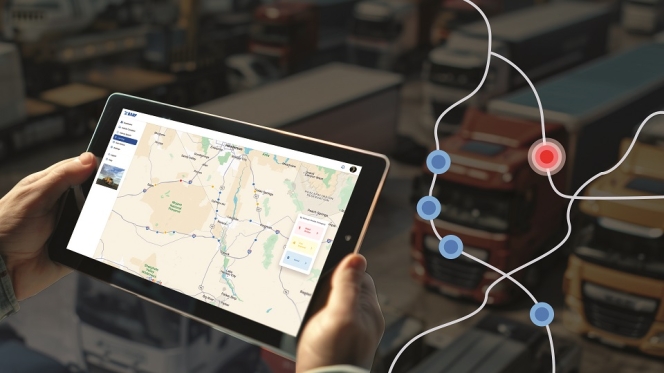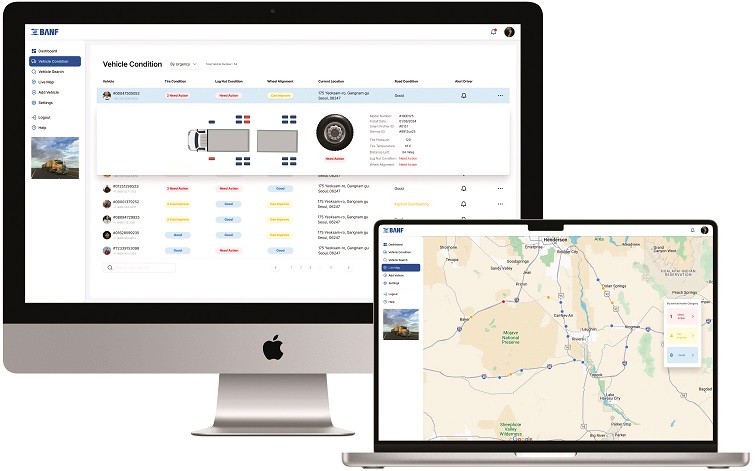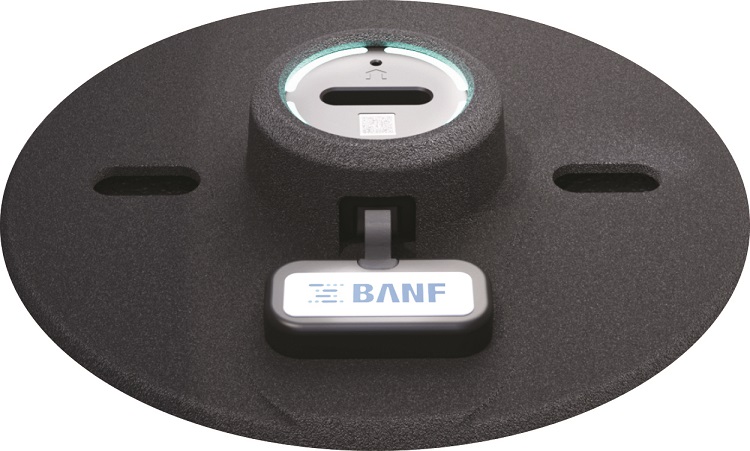- BANF
- tyre pressure monitoring system
- TPMS
- Ron Yoogun Lee
- Begin a New Future
- South Korea
- Volvo
- Hyundai
BANF Aims To Bring Real-Time Tyre Insights To Vehicles, Going Beyond TPMS
- By Nilesh Wadhwa
- January 08, 2025

South Korean start-up is transforming tyre safety by delivering real-time data insights that go beyond traditional TPMS, monitoring tyre pressure, temperature, wear and alignment. Targeted at fleet operators and manufacturers, BANF’s system improves vehicle safety, reduces costs and supports sustainability. With global partnerships including Volvo and Hyundai, BANF is also exploring market opportunities in India.
When it comes to vehicle safety and fuel efficiency, the role of tyres has often been underrated. Modern vehicles have undergone significant advancements over the decades, evolving from basic mechanical structures to sophisticated mechatronic and digital systems. However, for most, tyres remain largely unchanged – seemingly confined to the traditional black, rubber look without much technological upgrade.
The Tyre Pressure Monitoring System (TPMS), introduced in 1986 within high-end luxury cars, has yet to achieve global standardisation. Apart from a few countries where it is mandated, TPMS remains a novelty even in modern vehicles.
BANF (Begin a New Future), a South Korean start-up focusing on software and hardware technology to fully digitalise tyre information, is determined to change this. In an exclusive conversation with Tyre Trends, Ron Yoogun Lee, VP of Global Business Development at BANF, explains the company’s purpose:

“BANF was founded to address this critical need by integrating smart sensor technology and data analytics into tyre management. Our mission is to elevate vehicle safety, enhance tyre performance and reduce environmental impact through the digitalisation of tyre data. By providing real-time insights into tyre conditions, BANF empowers fleet operators, manufacturers and drivers to optimise maintenance, lower costs and promote sustainability. This drives us to tackle industry challenges with transformative solutions, pioneering a safer and more connected future for mobility.”
Expanding beyond basic TPMS capabilities
Lee explains that one of the primary limitations of current TPMS is its restricted data scope. Traditional TPMS sensors monitor tyre pressure at low frequencies, transmitting data every few minutes but focusing solely on air pressure.
BANF’s technology, however, gathers a wider range of tyre data, including pressure, temperature, tread wear, wheel alignment and even lug nut stability. This approach goes well beyond air pressure monitoring, providing insights that make tyres ‘smarter.’
Using machine learning, BANF’s system analyses the data to offer valuable insights to drivers and fleet operators regarding not only tyre health but also cargo load measurements and road surface conditions. The data is reportedly up to 90 percent accurate.
Lee details the core of BANF’s solution, which is built on two main components:
Tyre-Mounted Sensor (iSensor): A 3-axis accelerometer-based sensor attached (glued) inside the tyre’s inner liner, the only point of contact between the vehicle and the road.
Smart Profiler (Transmitter): Mounted on the mud flap or wheel arch and connected to the vehicle’s battery, this device wirelessly powers the sensor using magnetic resonance, gathering data on the tyre's internal and external conditions.

“Unlike standard TPMS, our system collects and analyses a comprehensive range of data points, offering real-time insights into tyre health and performance. This includes not only pressure but also factors such as temperature, tread wear and load, providing a more complete picture of the tyre’s condition,” he says.
BANF considers its unique selling point to be its advanced digitalisation and data analytics capabilities. The system empowers fleet managers, manufacturers and drivers to make proactive, data-driven decisions to enhance safety, optimise tyre performance and reduce maintenance costs. This comprehensive approach to tyre monitoring addresses the limitations of traditional TPMS, meeting the rising demand for safer, smarter and more efficient mobility solutions.
Continuous power and data collection
BANF’s technology enables continuous power supply to high-speed rotating tyres using resonant wireless power transmission. This allows the internal sensors to continuously collect data while driving, capturing 3-axis (X, Y, Z) accelerometer data to support advanced algorithm development. Additionally, BANF leverages mathematical modelling expertise to ensure high efficiency and minimal error in resonant wireless power environments.
Despite TPMS technology existing for over four decades, it still lacks widespread adoption. Why is that? Is it due to cost, awareness or maturity of the technology? Lee attributes the slow adoption of basic TPMS to limited consumer awareness and the system’s restricted functionality.

While TPMS provides basic air pressure information, it does not address other crucial aspects of tyre health, such as temperature, tread wear and load. This limited capability diminishes its perceived value, especially among consumers and manufacturers seeking comprehensive solutions.
“However, with the inevitable rise of electric vehicles (EVs) and autonomous vehicles (AVs), the demands on tyres are increasing. EVs, with their heavier batteries and higher torque, place additional stress on tyres, while AVs, designed for continuous operation, further amplify this strain. Traditional tyre monitoring methods, such as visual inspection, are inadequate for autonomous vehicles. As these trends reshape the automotive landscape, the need for advanced tyre monitoring systems that go beyond basic TPMS is growing. This shift will likely increase consumer awareness and drive the adoption of more comprehensive tyre monitoring solutions,” explains Lee.
While BANF may still be relatively unknown, the Korean start-up is already collaborating with major players like CampX by Volvo Group, Hyundai Motor Group, DHL and more than 20 other global organisations.
“Our primary target clients are fleet management companies operating commercial vehicles, particularly in the Truck and Bus Radial (TBR) segment. These clients benefit most from our advanced tyre monitoring solutions due to the significant return on investment (RoI) from optimised tyre usage, enhanced safety and reduced maintenance costs. By providing real-time insights into tyre health, we enable fleet operators to make data-driven decisions that minimise downtime and maximise efficiency. We currently produce 1,000 units monthly and are expanding our manufacturing capabilities,” shares Lee.
Plans for India and tyre safety
India, traditionally a cost-conscious market, has emerged as a major manufacturing hub and one of the fastest adopters of new technologies. In response to a question on BANF’s potential interest in India, Lee reveals:
“We are currently working with several companies in India, including major tyre manufacturers, vehicle manufacturers and last-mile fleet operators. We are supported by KISED, an arm of the Ministry of SMEs of Korea and NIPA, part of the Ministry of Science and ICT. We are actively engaging with stakeholders in the Indian innovation ecosystem and will be visiting India shortly to strengthen partnerships and explore further opportunities.”
Acknowledging India’s cost-sensitive market, Lee adds, “We are considering options for a facility setup worldwide, with India being one of our top choices.”
Road safety remains a priority for both the Indian automotive industry and the world. Despite numerous initiatives and technologies, the World Health Organisation (WHO) reports that 1.19 million lives are lost in road accidents each year. Road traffic injuries are the leading cause of death for children and young adults aged 5–29 years, with 92 percent of fatalities occurring in low- and middle-income countries.
Focus areas for tyre industry safety and efficiency
Lee identifies three key areas where the tyre industry can improve safety and efficiency:
1. Advanced Materials: Developing new tyre compounds that enhance durability and reduce rolling resistance can improve safety and energy efficiency. Lightweight, high-strength materials reduce energy loss and extend tyre life, crucial for EVs demanding lower energy consumption for longer range.
2. Intelligent Monitoring Systems: Smart sensors to monitor tyre health in real-time are increasingly essential. By tracking metrics such as pressure, temperature, tread wear and load, intelligent systems can alert drivers or fleet managers to potential issues before they escalate. This proactive approach enhances safety and fuel efficiency, as well-maintained tyres contribute to better aerodynamics and lower fuel consumption.
3. Sustainable Manufacturing: Optimising production to minimise environmental impact is crucial. Using eco-friendly materials, reducing waste and recycling tyres contributes to a more sustainable industry, aligning with global trends towards green manufacturing and supporting the energy efficiency goals of the automotive industry.
INTERVIEW: Ron Yoogun Lee
What are the upcoming key trends you see in the tyre industry?
One of the key trends in the tyre industry is the increasing emphasis on safety. As vehicles become more advanced, with a growing number of electric vehicles and autonomous vehicles entering the market, the demands placed on tyres are intensifying. EVs, for instance, have heavier loads and higher torque, which increase wear and tear on tyres, while AVs require consistent, reliable performance to operate safely around the clock. These factors are driving the need for smarter tyre solutions that go beyond traditional monitoring systems.

There is a growing demand for intelligent tyre technologies that provide real-time data on various parameters like pressure, temperature, tread wear and load. Such capabilities allow fleet operators, manufacturers and individual drivers to maintain tyre safety proactively, reduce maintenance costs and ensure optimal performance under diverse conditions. Meeting the advanced requirements of EV and AV clients is crucial, as their vehicles rely on enhanced tyre performance for safety and efficiency. As a result, the industry is moving towards digitalisation and smart sensors to address these evolving needs, marking a significant shift in tyre technology and monitoring.
What is BANF’s business plan (OE supplier), or you will also look at aftermarket opportunities?
BANF’s business plan primarily centres around building strong partnerships with Original Equipment (OE) manufacturers and OE suppliers. Our goal is to enhance tyre safety and efficiency directly at the manufacturing stage, ensuring that end customers benefit from high-quality, intelligent tyre solutions from the outset. Currently, our focus is on the commercial vehicle segment, where we see substantial demand for advanced tyre technology to improve safety, performance and operational efficiency.
That said, we also recognise the significant potential in the aftermarket sector and are actively exploring opportunities to expand into this space. The aftermarket offers us the chance to provide a wider range of products and services directly to end-users. By pursuing both OE partnerships and aftermarket avenues, we aim to deliver innovative tyre solutions that meet the evolving needs of our customers across the entire lifecycle of their vehicles.
What are the other products or areas that you would look to focus on?
Looking ahead, we still believe there is a lot can come out from tyre. We are currently developing many other advanced features to be announced soon. In a sense of product portfolio, we are looking into two-wheeler, three-wheeler market and also airplane tyres.
PCBL Chemical Appoints Nilesh Koul As Managing Director
- By TT News
- November 05, 2025

In a significant leadership transition, PCBL Chemical, a part of the RP-Sanjiv Goenka Group, has appointed Nilesh Koul as its Managing Director for a five-year term, effective immediately. The company's Board confirmed this appointment during its meeting on 3 November 2025 subject to final ratification by shareholders through a postal ballot. This change was prompted by the resignation of the former Managing Director, Kaushik Roy, who stepped down for personal reasons, effective from the same date. The Board emphasised that selecting Koul is a strategic step aimed at ensuring leadership continuity and driving the company's future growth.
Koul is an experienced leader with a career spanning 28 years across diverse sectors including metals, oil and gas, construction materials and FMCG. His professional background includes senior executive roles at prominent organisations such as Hindalco Industries, British Petroleum, Castrol India, LafargeHolcim and Pidilite Industries, where he managed international operations. His most recent position was Senior President and CEO of the Aluminium Downstream business at Hindalco Industries. Academically, he is a graduate of G B Pant University and an alumnus of IIM-Ahmedabad, and he also serves on the Board of the Aerospace India Association.
Tire Rack Co-Founder Mike Joines Inducted Into Tire Industry Hall Of Fame
- By TT News
- November 05, 2025

Tire Rack is celebrating the induction of its co-founder and longtime CEO, Mike Joines, into the Tire Industry Hall of Fame. The company credits Joines' automotive passion as the foundational spark for its mission to transform the tyre industry. Under his leadership, Tire Rack pioneered one of the first e-commerce platforms for tyre retailing, fundamentally changing how consumers research and purchase tyres.
The company’s philosophy, established by Joines, centred on empowering customers through comprehensive information rather than just completing a sale. This customer-first approach was built upon providing detailed product reviews, performance testing data, side-by-side comparisons and expert guidance.
Tire Rack also acknowledges that Joines understood the critical role of its team, noting that the ingenuity and integrity of its employees have been the true driving force behind decades of innovation and sustained customer trust. The company honours Joines as an enthusiast, innovator and leader whose devotion remains a source of inspiration.
Goodyear Posts USD2.2 Billion Quarterly Loss As It Completes Divestitures Under Goodyear Forward Plan
- By Sharad Matade
- November 04, 2025

Goodyear Tire & Rubber reported a net loss of USD 2.2 billion for the third quarter of 2025, weighed down by significant non-cash charges, even as its “Goodyear Forward” transformation programme continued to deliver strong operational benefits and major divestitures were completed.
The tyre maker said segment operating income rose to USD 287 million in the quarter, reflecting USD 185 million in cost-saving benefits from Goodyear Forward, which helped offset inflationary pressures, lower volumes and the absence of prior-year insurance recoveries.
“We delivered a meaningful increase in segment operating income relative to the second quarter in an industry environment that continued to be marked by global trade disruption,” said Mark Stewart, Chief Executive Officer and President. “This growth underscores our strong product portfolio and the consistency of our execution under the Goodyear Forward plan, both of which we expect to support further acceleration in our earnings during the fourth quarter.”
Goodyear’s quarterly net sales were USD 4.6 billion, with tyre unit volumes at 40 million. The company recorded a USD 1.4 billion non-cash deferred tax asset valuation allowance and a USD 674 million goodwill impairment charge during the quarter. Adjusted net income was USD 82 million, compared with USD 102 million a year earlier.
The company stated that all planned asset sales under its Goodyear Forward plan had now been completed, generating total gross proceeds of approximately USD 2.2 billion, which will be used to reduce debt and reinvest in growth.
On 31 October, Goodyear finalised the sale of the majority of its Goodyear Chemical business to an affiliate of Gemspring Capital Management, LLC, for USD 650 million, subject to adjustments. At closing, Goodyear received approximately USD 580 million in cash, which reflected working capital adjustments, including those for intercompany receivables.
“With the sale of our Chemical business, we have completed all of the planned asset sales included in our Goodyear Forward transformation program,” said Stewart. “Additionally, we surpassed initial expectations, with total gross proceeds from the divestitures of approximately USD 2.2 billion. As a result, we have a more focused, streamlined portfolio that will allow us to grow our core products and services and achieve our vision of being #1 in Tires and Service.”
The sale included Goodyear Chemical facilities in Houston and Beaumont, Texas, as well as a research office in Akron, Ohio. The company retains its chemical plants in Niagara Falls, New York, and Bayport, Texas, as well as the rights to the products produced there.
By region, the Americas segment reported third-quarter sales of USD 2.7 billion, a 4.2 percent year-over-year decline, as replacement tyre volumes decreased due to high inventories of imported products in the US market. Segment operating income fell to USD 206 million from USD 251 million.
In Europe, the Middle East and Africa (EMEA), sales rose 4.4 percent to USD 1.4 billion, supported by favourable currency movements and stronger price/mix. Operating income increased to USD 30 million from USD 23 million a year earlier.
Asia Pacific sales fell 18.9 percent to USD 501 million, reflecting the sale of the Off-the-Road (OTR) tyre business and softer demand in Japan, Australia and China. Segment operating income dropped to USD 51 million from USD 72 million.
Goodyear said it expects to achieve about USD 1.5 billion in annualised run-rate benefits from the Goodyear Forward programme by the end of 2025.
Nitto Tire’s Tomo Mizutani inducted into Tire Industry Hall of Fame
- By TT News
- November 04, 2025

Tomoshige “Tomo” Mizutani, advisor and former Chairman and Chief Executive of Nitto Tire USA Inc., has been inducted into the Tire Industry Hall of Fame, one of the sector’s most prestigious honours.
The induction, hosted by the Tire Industry Association (TIA), will take place in Las Vegas alongside the 2025 SEMA Show, running from November 4 to 7.
With more than four decades in the tyre industry, Mizutani is widely credited with transforming Nitto Tire USA from a struggling operation in the early 1990s into a billion-dollar brand recognised for its innovation, performance, and strong connection with car enthusiasts.
“Our 2025 inductees embody the spirit of innovation and service that defines the tyre industry,” said Dick Gust, CEO of the Tire Industry Association. “Their contributions have improved safety, expanded opportunity, and shaped the way we do business worldwide.”
Mizutani’s approach combined deep market insight with bold risk-taking. By engaging with emerging communities of young car enthusiasts and later expanding into the off-road segment, he helped reposition Nitto as a brand built around passion and creativity.
Known for embracing innovation, Mizutani was among the first to champion enthusiast-driven product development and leverage digital and social media marketing to build brand loyalty. Under his leadership, Nitto cultivated a social media community exceeding 13 million followers, making it one of the most engaged automotive brands online.
“When new game-changing innovations would arise,” Mizutani said, “we viewed them as huge opportunities instead of risks.”
A frequent speaker at leading universities and industry events, Mizutani has shared his philosophy of creativity, resilience and perseverance with aspiring business leaders, often reminding audiences to “never ever give up.”
“This honour is beyond my dreams,” Mizutani said. “I’ve been privileged to meet and learn from industry legends who inspired me since my first day in America. I am deeply grateful for the incredible people who have guided, challenged, and supported me throughout my journey.”







Comments (0)
ADD COMMENT